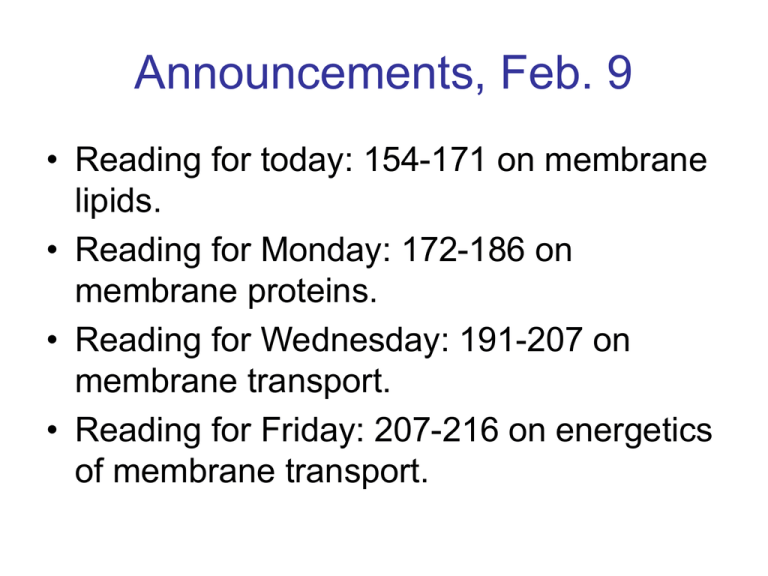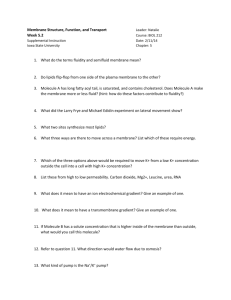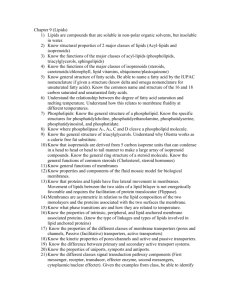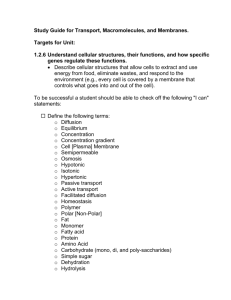Outline Day 8
advertisement

Announcements, Feb. 9 • Reading for today: 154-171 on membrane lipids. • Reading for Monday: 172-186 on membrane proteins. • Reading for Wednesday: 191-207 on membrane transport. • Reading for Friday: 207-216 on energetics of membrane transport. Outline/Learning Objectives I. Membrane lipids A. Membrane functions B. Isolating membrane lipids C. Historical models of membranes D. Fluid mosaic model E. Evidence concerning lipid part of membrane After reading the text, attending lecture, and reviewing lecture notes, you should be able to • List various functions of membranes. • Explain how thin-layer chromatography (TLC) can be used to fractionate lipids. • Compare historical models of membrane structure. • Describe experimental evidence for membrane lipid composition, structure and fluidity. Membrane Functions Membranes: How would you study them? Lyse w/ dH2O, centrifuge Plasma membrane “ghosts” Extract w/ chloroform-MeOH Centrifuge pellet SDSPAGE: Proteins separated by size: smallest travel farthest supernatant TLC: Lipids separated by polarity: least travels farthest MB phospholipids Note: backbone is glycerol Note: backbone is serine Historical models of membrane structure • Gorter and Grendel (1925) – Estimated red cell surface area and extracted lipid from "ghosts." – Predicted that area of RBC was 100 m2, found that area covered by lipid was 200 m2 , indicating a bilayer • Davson and Danielli Model (1935) – How does differential permeability come about? – Proposed lipid bilayer + protein lamellae on each side (sandwich), pores allowed substances in or out. • Robertson (1960) – Viewed membranes with EM, seemed to agree with Davson and Danielli model – Suggested that all membranes of the same composition (unit membrane). – But unit MB model did not account for chemical differences in membranes Fluid Mosaic Model Singer and Nicholson (1972) Science 175:720 1. Evidence of the phospholipid composition: TLC of various membranes Conclusion: 2. Evidence for Lipid Bilayer: X-ray crystallography of Membranes 10 nm • X-ray crystallography of membranes directly reveals the bilayer structure. • Polar head groups scatter electrons more at peaks. • Distance between peaks is 10 nm. Data Interpretation distance Asymmetry and Movement of PLs • Functional significance: – Contributes to net negative charge on inside – PI is available for signaling function on inside. – Glycolipids in outer leaflet, so CHO out. • Inequality is maintained by movement properties of phospholipids within the membrane • Membrane asymmetry is generated – Rotation and lateral diffusion during synthesis in the ER: • PC, SM mostly in outer leaflet • PE, PS, PI mostly in inner leaflet • Cholesterol: 50% inner, 50% outer is rapid – Transverse diffusion or "flipflop" is rare, mediated by protein translocases. 3. Evidence for Lipid Fluidity: Fluorescence Recovery After Photobleaching (FRAP) Lipids labeled 4. Evidence for Fluidity: Differential Scanning Calorimetry • Measures uptake of heat during phase transitions of lipids. • Below the transition temperature (Tm) lipids are solid, above Tm lipids are fluid. • Saturated fatty acids have a higher Tm while unsaturated fatty acids have a lower Tm (more fluid). Why? – Double bonds make kinks in the tails, which disrupt the crystal structure. Monounsaturated saturated • Longer fatty acid chains have a higher Tm while shorter fatty acids have a lower Tm (more fluid). Effects of Chain Length and Double Bonds on Tm Less fluid → More fluid → Effect of Unsaturated Fatty Acids on Fluidity • C=C in FA creates kinks in chain, so they pack together less well. • Less able to form crystalline solid, therefore stays liquid. • Organisms in cold environments increase the # of unsaturated FAs in their membranes. MB Fluidity Depends On: • Temperature – Higher T, greater fluidity; cells can’t change. • Unsaturated FAs – Increase fluidity • Length of FAs – Shorter, more fluid • Cholesterol – Fluidity “buffer” Cells can regulate Effect of Cholesterol on Fluidity • Animal cells contain up to 50% cholesterol in their membranes. • OH of cholesterol hydrogen bonds with O of ester bonded fatty acid, while hydrocarbon rings interact with hydrophobic hydrocarbon chains of fatty acids Acts as a fluidity buffer: Makes MB less fluid at higher temperatures than without cholesterol, since FA’s immobilized Makes MB more fluid at lower temperatures than without cholesterol, since it disrupts packing into a crystal. Summary: Evidence concerning the Lipid Portion of the Membrane 1. Estimated and measured surface area • 2. Membrane is a bilayer. Electron microscopy • 3. Trilaminar appearance of membranes. X-ray crystallography • 4. Membrane is a bilayer. Thin-layer chromatography • 5. Different membranes contain different phospholipids. Fluorescence recovery after photobleaching of lipids • 6. Membranes are fluid. Differential scanning calorimetry • The phospholipid composition of membranes determines how fluid they are. A recent twist on the Fluid Mosaic Model: Lipid rafts Or Outside cell • Small, specialized areas in membrane where some lipids (primarily sphingolipids and cholesterol) and proteins are concentrated. – Two monolayers move together; thicker, less fluid than normal membrane • Function: signaling and/or transport of membrane proteins? Visualization of Lipid Rafts Atomic force microscopy reveals sphingomyelin rafts (orange) protruding from a PC background (black) in a mica-supported lipid bilayer. Placental alkaline phosphatase (yellow peaks), a GPI-anchored protein, is shown to be almost exclusively raft-associated. For details see the article by Saslowsky et al. J. Biol. Chem. 277, Cover of #30, 2002. CHO modification of Glycolipids: The ABO blood groups • Glycolipids partition into lipid rafts on non-cytosolic side • Sugars added in lumen of Golgi, e.g. AB antigens. • Recall the genetics: A antigen A allele HH or Hh Precursor H substance H Substance hh B allele B antigen ABO Blood Groups A - A antigen only B - B antigen only AB - Both A and B antigens O - Neither antigen








